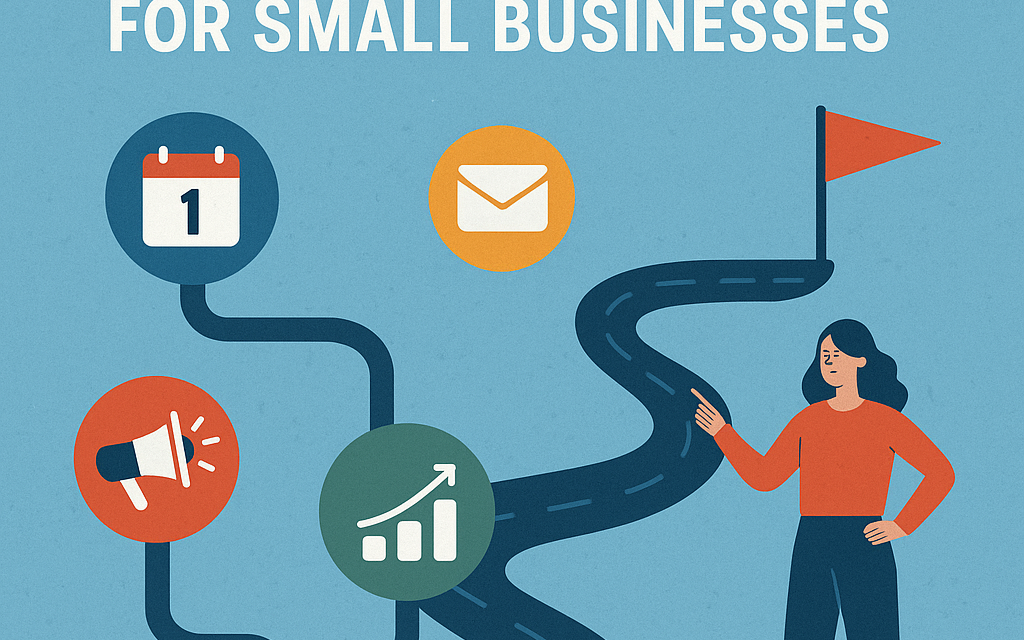The 30‑Day Digital Marketing Roadmap for Small Businesses
Audience: late 20s to early 30s founders, freelancers, and side‑hustlers who can already film and record. The goal is to turn your content skills into customers in 30 days—without needing a full‑time team or a huge budget.
What you’ll have by Day 30
– A lean brand system: clear positioning, messaging, and visual kit
– A high‑converting landing page or site with analytics and pixels
– One pillar video, 12–24 short videos, a lead magnet, and an email welcome series
– Baseline SEO (keywords, on‑page, Google Business Profile)
– A simple paid test, retargeting, and a review/referral loop
– A weekly newsletter and an editorial pipeline you can maintain
– A KPI dashboard, working offers, and a 90‑day growth plan
Principles to keep you sane
– Compounding beats bursts: publish small, daily, consistent outputs.
– Distribution > perfection: 80% quality shipped beats 100% never posted.
– Build growth loops: content → capture email → nurture → offer → ask for review/referral → back to content.
– Track one “North Star” (leads or sales) plus a few input metrics (posts, emails, outreach).
Time budget
– Weekdays: 60–120 minutes/day
– Weekends: 2–3 hours for batching
– Ad budget (optional): start with $10–$20/day
Week 1: Foundation and fast setup (Days 1–7)
Day 1 – Define your goal, customer, and offer
– Pick a single, measurable 30‑day goal (e.g., 50 email subscribers or $1,500 in new sales).
– Ideal Customer Profile (ICP): job/life stage, urgent pains, desired outcome, budget, where they hang out online.
– Offer clarity: what result you deliver, in how long, for how much; one entry offer and one core offer.
Day 2 – Messaging and brand voice
– One‑liner formula: We help [ICP] achieve [outcome] without [pain] in [timeframe].
– Brand voice notes: 3 adjectives (e.g., candid, smart, playful). Write 10 hooks and 10 CTAs in this voice.
– Proof library: collect testimonials, screenshots, before/after, portfolio links.
Day 3 – Quick audience research sprint (3–4 hours)
– Social listening: read 30 comments each on competitor posts, Reddit, TikTok/IG. Note exact phrases, objections, and questions.
– Build a swipe file: headlines, thumbnails, angles that performed.
Day 4 – Core assets and tracking
– Website/landing page: one clear page with headline, benefits, proof, CTA.
– Install GA4, Search Console, and pixels (Meta, TikTok, YouTube). Turn on UTM tracking.
– Set up Google Business Profile (for any local/service angle) and complete NAP info.
Day 5 – SEO essentials
– Make a keyword shortlist: 5 primary terms with purchase intent + 10 long‑tails from “People also ask.”
– On‑page: unique title tag, meta description with CTA, H1/H2s, internal links, compress images, add alt text.
– Add local/schema basics (Organization, Product/Service, FAQ).
Day 6 – Email + CRM
– Choose an ESP (Mailchimp, ConvertKit, Beehiiv, Klaviyo for ecom).
– Create a simple lead magnet idea: checklist, price guide, mini template, or cheat sheet.
– Build a signup form, a thank‑you page, and a 3‑email welcome sequence outline.
Day 7 – Content plan and calendar
– Content pillars (3–5): Education, Transformation (case studies), Behind‑the‑Scenes, Objection Busting, Offers.
– Shot list: script 1 pillar video (8–12 min) and outline 12 short videos (30–60 sec).
– Calendar: set your cadence (e.g., 3 shorts + 1 long per week, 1 email weekly). Reserve one engagement block/day (15 minutes).
Week 2: Make high‑leverage content and capture leads (Days 8–14)
Day 8 – Film your pillar video
– Structure: cold open hook (5–7 sec), promise, steps, proof, CTA to lead magnet.
– Record b‑roll and screen captures you can reuse in shorts and carousels.
Day 9 – Repurpose day
– Cut 8–12 Shorts/Reels/TikToks from the pillar. Vary hooks and CTAs.
– Turn the transcript into a 900–1,200‑word blog post and a 6–8 slide carousel.
– Pull 5 punchy quotes for social and 3 FAQs for your site.
Day 10 – Edit, package, and schedule
– Thumbnails: one bold word + face or product; test two versions.
– Captions: write scannable first lines and add 3–5 specific hashtags.
– Schedule posts across YouTube Shorts, IG Reels, TikTok, and LinkedIn (if B2B).
Day 11 – YouTube and on‑platform optimization
– Titles that promise a clear outcome (“Do X in Y days without Z”).
– End screens and pinned comments driving to the lead magnet.
– Playlists by buyer journey stage: “Start Here,” “How‑Tos,” “Case Studies.”
Day 12 – Build and launch the lead magnet
– Create the asset (2–4 pages is fine). Include a quick win and soft CTA to your entry offer.
– Landing page copy: problem → promise → preview → proof → form.
– Thank‑you page: deliver the asset and present a time‑boxed offer or booking link.
Day 13 – Welcome sequence goes live
– Email 1 (instant): deliver magnet + personal story + simple question (“What’s your biggest challenge with X?”).
– Email 2 (Day 2): a how‑to tip + case study.
– Email 3 (Day 4): objection busting + soft offer.
– Add tags for replies to segment hot topics.
Day 14 – Partnerships and community
– Build a list of 20 micro‑creators or local partners. Propose a joint live, carousel swap, or newsletter blurb.
– Join 2–3 relevant communities (Slack, Facebook Groups, subreddits). Contribute value first; pitch later.
Week 3: Distribution, reviews, and paid tests (Days 15–21)
Day 15 – Organic distribution sprint
– Post your best short natively on each platform and spend 30 minutes engaging: meaningful comments on 10 posts, reply to all DMs/comments.
– DM warm leads a relevant clip and ask a qualifying question.
Day 16 – Google Business Profile + reviews
– Add photos, services, and a compelling description. Post an update.
– Send 15 personalized review requests with a direct link and a prompt (“Could you mention speed and communication if that stood out?”).
Day 17 – Paid traffic test (optional but powerful)
– Objective: conversions or leads. Two audiences (interest vs. lookalike), two creatives (talking head vs. demo).
– Budget: $10–$20/day for 5–7 days. Use UTMs and pin a baseline CPC/CPM/CTR.
– KPI to beat: CTR > 1.5% on short‑form, Landing page CVR > 3–5% for services, 2–4% for ecom add‑to‑cart.
Day 18 – Retargeting setup
– Create 7–14‑day warm audiences: site visitors, video viewers >50%, engagers.
– Retarget with social proof and a simple offer. Cap frequency at 2–3/day.
Day 19 – Referral and UGC loop
– Launch a simple referral: “Get 10% off or a free add‑on when a friend buys.”
– Invite user‑generated content: prompt customers to post and tag you; share the best with permission.
Day 20 – Earned media micro‑PR
– Pitch 5 niche newsletters, 5 podcasts, or local media with a value‑first angle (data, checklist, story).
– Offer a free mini training for their audience in exchange for a link to your lead magnet.
Day 21 – Analytics checkpoint and iteration
– Review: which hook formats and topics got the longest watch time and best CTR?
– Kill the bottom 20% angles, double down on the top 20%. Write 10 new hooks from winners.
Week 4: Scale, automate, and convert (Days 22–30)
Day 22 – Conversion rate optimization (CRO)
– Test your hero headline and primary CTA. Add 3–5 trust elements above the fold (logos, reviews, guarantees).
– Add a lightweight chat widget or booking link. Improve page speed.
Day 23 – Automation and lifecycle email
– Build one more flow: abandoned cart/quote follow‑up, browse abandonment, or post‑purchase review request.
– Add a weekly newsletter rhythm: one practical tip, one story, one CTA.
Day 24 – Offers and pricing
– Create an intro offer or bundle with a fast win in 7 days.
– Map your value ladder: intro → core → subscription/retainer or repeat purchase plan.
Day 25 – Sales enablement
– Draft a simple discovery call script or DM framework: problem, impact, fit, next step.
– Objection handling doc: price, time, trust; craft one story or proof point per objection.
Day 26 – Second pillar content and a case study
– Film a case‑study style video with hard numbers or before/after.
– Turn it into a one‑pager PDF you can send after discovery calls.
Day 27 – Systems and SOPs
– Document your workflow: ideate → script → shoot → edit → publish → repurpose → report.
– Create templates for hooks, descriptions, thumbnails, UTM naming, and outreach DMs.
Day 28 – Budget and channel plan for the next 60 days
– Allocate: 40% to what’s working, 40% to testing adjacent audiences/creatives, 20% to experiments (new channels/formats).
– Set caps: CAC target, frequency limits, daily spend.
Day 29 – Launch a 72‑hour promo or live event
– Options: time‑boxed discount, value‑add bonus, free consults, or a workshop/live demo.
– Promote across email (3 sends), socials (daily), Stories, and a pinned comment.
Day 30 – Retrospective and 90‑day plan
– Document: what worked, what didn’t, surprises, decisions.
– Set next targets: content volume, email list growth, revenue. Lock in your weekly cadence on the calendar.
Platform‑specific cadence (suggested)
– YouTube: 1 pillar/week, 2 Shorts/week. Playlist‑driven.
– Instagram/TikTok: 3–5 Reels/TikToks/week, 3–7 Stories/week, 1 carousel/week.
– LinkedIn (B2B): 3 posts/week (1 video, 1 carousel, 1 text post).
– Email: 1 newsletter/week + 1 automation flow running.
Fast content prompts (because you can already shoot)
– Do this, don’t do that: three mistakes and what to do instead.
– $X challenge: achieve Y result in Z days.
– Live teardown: your screen + voiceover fixing a real problem.
– Price transparency: what it costs and why.
– Before/after transformation with step‑by‑step breakdown.
– “If I had to start from zero with $500…” budget plan.
– Reaction with value‑add: stitch or duet plus your framework.
Hook formulas to copy
– I tried [method] so you don’t have to—here’s what actually moved the needle.
– Stop [common mistake]. Do this instead: [one‑liner].
– The 3‑step playbook I use to get [outcome] in [timeframe].
– What no one tells you about [desired outcome] (and what to do about it).
– If you’re [ICP], save this.
CTA library
– Grab the free [checklist/template]; link in bio/description.
– Comment “PLAN” and I’ll DM you the roadmap.
– Book a 15‑minute fit call; limited spots this week.
– Join 500+ [ICP] getting one actionable tip every Friday.
Minimum viable tool stack (pick what you’ll actually use)
– Site/landing: Webflow, Squarespace, or Shopify for ecom.
– Analytics: GA4, Search Console; pixels for Meta/TikTok/YouTube; Bitly or UTM builder.
– Email: Mailchimp/ConvertKit for services; Klaviyo for ecom; Beehiiv for media‑style.
– Scheduling: native app schedulers or tools like Buffer/Later.
– Thumbnails/graphics: Canva or Figma.
– Project management: Notion or Trello.
– Review management (local): Google Business Profile + a simple review link.
Baseline metrics to watch
– Content: 3‑second view rate, average watch time, saves/shares, link CTR.
– Traffic: sessions, top pages, sources, time on page, bounce/engaged sessions.
– Conversion: landing page CVR (aim 3–10% depending on offer), checkout start rate, purchase rate or booked calls.
– Email: opt‑in rate (2–5% sitewide; 20–40% on lead magnet pages), open rate (30–50%), click rate (2–5%).
– Paid: CTR > 1.5–2.0%, CPC within target, CAC within 10–30% of AOV for ecom or < 10–20% of first‑month value for services.
Quick variations by business type
– Services/local: prioritize Google Business Profile, reviews, and booking flow. Content should showcase process and outcomes; push to consults.
– E‑commerce: focus on UGC and demo content, bundles/intro offers, and email flows (welcome, browse abandon, post‑purchase).
– Education/coaching: lead magnet + webinar/workshop, community building, and long‑form YouTube as the trust engine.
Compliance and trust basics
– Privacy policy and terms linked in footer. Cookie consent if you’re running pixels.
– Disclose sponsored content/affiliations. Use your own results or clear client permissions.
– Always get permission before sharing customer UGC.
What “good” looks like by Day 30 (ballpark)
– 1–2 pillar videos, 12–24 shorts, 1–2 carousels, 1 lead magnet, 3‑email welcome sequence
– 100–500 new followers across platforms, 50–250 email subscribers
– First 1–5 sales or 2–10 booked calls (depending on offer/price point)
– Clear signal on 2–3 winning hooks and one channel to double down on
Keep the momentum: the 3‑hour weekly maintenance plan
– 60 minutes: shoot 4–6 shorts.
– 45 minutes: edit/schedule, write thumbnails/titles.
– 30 minutes: analytics review; decide next week’s hooks.
– 30 minutes: email newsletter.
– 15 minutes/day: comments, DMs, and outreach.
If you stick to this 30‑day roadmap, you’ll have a working growth engine, not just scattered posts. Your content skills become a system that captures attention, converts it into leads, and turns those leads into customers—on repeat.





